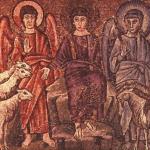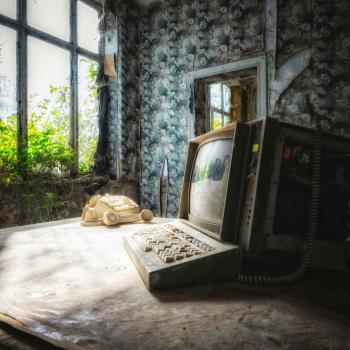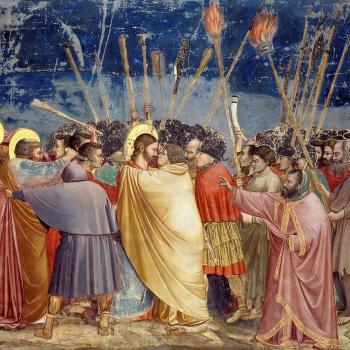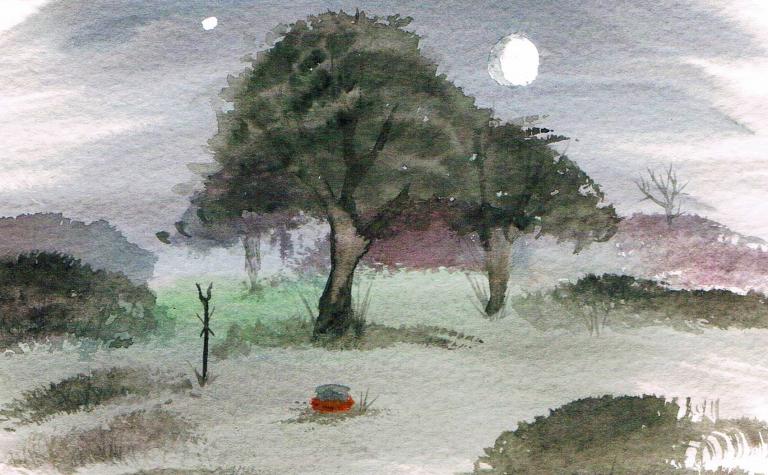
[Originally scrivened a decade ago, this piece reflects some of my thoughts from that time which were guided through Gnostic expressions of Craft lore. Evidenced here are considerations of Biblical and pre-Biblical texts (Enûma Eliš) which inform Old Testament, particularly Genesis, mythologies. Much Craft lore contains within its mythologies references which draw from this potent stream, which are useful and available narratives which can be utilised by the cunning person. Given its age, some ideas developed here may have been outgrown by the author. My decision has been to leave it as it is, with scant editing, and as it was (as far as my memory serves) unpublished, I must deduce that I had regarded it incomplete, or obsolete to my magical thinking and development. It is interesting that, in the lead up to 2012 and the many apocalyptic predictions that prevailed at the turn of the last decade, global events have since escalated beyond what could have been imagined. Indeed, I often half-jokingly muse that the world must, surely, have ended in 2012 when the Large Hadron Collider caused a rift in the multiverse, allowing us to slip into an alternative and unbelievable timeline. Regardless, here we are, and here is something I wrote way back then… ]
“Tear down the house and build a boat!
Abandon wealth and seek living beings!
Spur possessions and keep alive living beings!
Make all living things go up into the boat.”
“Previously Utanapishtim was a human being.
But now let Utanapishtim and his wife become like us, the gods!”
Gilgamesh tablet XI, The Story of the Flood, 7th Century BCE
“Without pain, without sacrifice, we would have nothing.”
Fight Club, Chuck Palahniuk 1996
The ancient clay tablet, belonging to the epic of Gilgamesh, was found in Mesopotamia and dates to around the 7th Century BCE, making it truly a remarkable record of human imagination. It evidences one of the first myths of the deluge that later became immortalised in the Western world through the Old Testament account of Noah – the tenth, and last, pre-Flood patriarch of the Hebrew Bible. Modern interpretation often asserts that the story tells of a real event mythologised by our ancestors, preserving the essence of a catastrophe that threatened the very existence of human civilisation, so young in its infancy. With tsunami’s and natural disasters wreaking havoc on the globe over the last few years, it is poignant that the story of the flood comes to the fore and many have asked if the apocalypse is now. However, could it be that the so called apocalyptic texts and narratives have become abused of their original intent, the mystical nature of their mythology buried beneath generations of eroded traditions until, eventually, the cultures who inherit these works take them literally. Here, we will explore the metaphysical aspect of the flood and the apocalypse in terms of the mysteries, whose initiates undertook an apocalypse of the self to become ‘twice born’.
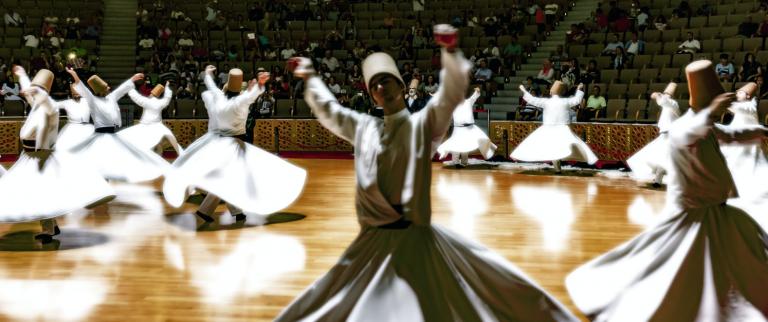
In Sufi mysticism, the word fana indicates the process of dying before the mortal body actually expires, usually by fire. A translation might be annihilation, which means a return to the condition of ‘no-thing’. In mystical traditions such as Kabbalah, this condition is that which precedes the universe in a traditional cosmogony and the Kabbalist phrase for this aspect which exists before the Tree of Life and, indeed, in which the Tree itself exists, is Ain Sof.
In a metaphysical sense, we each create the world around us and it is common when catastrophe strikes to hear the phrase “his world collapsed”. To the conscious observer, this is precisely what has happened and life, for that person, will never be the same again, coloured as it is by the trauma of such an initiatory the event. Such initiatory occurrences issue forth a new chapter in the life of the individual whose experience is unique and idiosyncratic; even when the event affects a group, we each react and partake differently. Depending upon the character of the individual, life may became a more joyous experience, encouraging us to live a more fulfilling experience of life. How apocalyptic events affect us can have a profound influence upon our journey through life and can be the catalyst for dramatic change. It is this observance that the mystery traditions of old understood and might provoke in order to pass the initiate through the gate and into a new experience, pushing through a paradigm shift to a relationship that is revealed (apocalypse) as one of co-creation with the threads of fate.

Returning to Noah, some believe that the Hebrew collators may have had access to an orally transmitted story that predates the surviving Babylonian tablets, which record the epic of Gilgamesh, by at least thousand years. This has lead anthropologists and historians to speculate that the flood story is so common to so many cultures that it preserves an actual catastrophic event or numerous prehistoric floods, which is why it features in so many separate mythologies, such as the Norse, the legend of Atlantis, Ogyges, and others. One line of thinking holds that the annual flooding of the Babylonian plains between the Tigris and Euphrates rivers may account for such legends in early traditions. However, the story of the flood, though, might not be a memory of turbulent climactic changes as much a mystical revelatory tradition with emphasis upon personal gnosis through initiatory ritual processes and preparation using crisis as a catalyst.
Such traumatic, apocalyptic, ritual is still practiced within certain occult traditions whereby candidates are variously treated to a series of trials before being received back into the whole. That each member has endured the same trials of the wasteland ensures that a bond of trust develops, as well as the egregore of the group being strengthened through such lived legacy. Such a method is employed in sometimes diluted form by Freemasons, Wiccans and perhaps the Society of the Horseman’s Word, to name a few. Records of the Horseman’s initiation ritual suggest that the candidate is first traumatised by the presence of ‘Old Clootie’, the devil as a grotesque beast replete with the pungent odour of brimstone. The initiate is put through a question and answer session which culminates in him believing he is about to be hanged, after which he must shake the cloven hand of ‘Old Nick’ himself. Such crises cause a jolt to the psyche in most individuals resulting in an exhilarating event that marks the passage from one life to a new one within the tradition, an end to life as it was known.
We learn from the Gilgamesh legend, described as a hero’s journey toward knowledge (gnosis), how the hero is to accomplish immortality, to realise his divine portion that is his birthright and cheat death and the Gods, becoming one with them. His instructor is none other than the flood survivor, Utanapishtim, who is made one of the gods by Enlil after he survives the flood himself. What makes this story more revealing than that of the Biblical Noah, and suggests that the Jewish writers of the Noah legend used it as a basis for their own legacy, is the instructions given to Utanapishtim. These directions, received from a divine source, suggest a hidden meaning that became buried by the time the Old Testament text was recorded. The message “spur possessions” has an ascetic quality that appears to have been missed until the present day. Chief Rabbi Andrew Sacks explained the flood story in the Jewish religion as a moral message in that Yahweh destroys mankind for being warlike and sinful. I would like to suggest that the flood story does not actually refer to the death of any human than the one receiving the divine message and that the myth should be interpreted to understand death as a great and significant change. That means that it is as relevant a story today as ever it was, and that it contains instruction of a gnostic expression from an ancient source. There is a longstanding tradition of mythological heroes representing the reader or listener and it is right that we should identify with the central characters. While the Gods are delivering the message to Utanapishtim, are we not too receiving the instructions passed on by the poet? Can we not “tear down the house and build a boat” and “spur possessions and keep alive living beings”?
Contemporary apocalyptic stories are still alive and well in the unconscious mind of our culture and civilisation. Films such as The Matrix and Fight Club preserve this tradition, floating like Yahweh’s cloud over the heads of most audiences. In Fight Club, Tyler Durden recites the potent words of advice that are unheeded by many cinema goers: “You are not your job. You are not how much money you have in the bank. You are not the car you drive. You are not the contents of your wallet ”. Within both of these films, the hero has a traumatic, apocalyptic, event during which their world is quite literally destroyed, their house torn down and rebuilt as a vessel better suited to navigate the high seas of reality as co-conspirator with fate.
A certain type of mythology often uses evocative analogy in order to transmit its message, and such could be the case with flood type apocalyptic tales. Impending doom teaches the hero in such myths how they should behave and the human spirit prevails in times of disaster, catastrophe often being the catalyst for change; humanity is at its best in crisis and one only has to think of recent flooding to observe how quickly material possessions lose their value when natural forces are challenging our very lives. All too often, it takes natural disaster, dire tragedy or war and conflict to awaken humanity from its ego obsessed slumber. Only in the depths of the abyss do we realise our true potential and release the spirit from its bonds. Natural disaster strips individuals of all the belongings and material objects that they use to identify themselves within the social context of civilisation. Without the attachment to those labels that make us who we are, we are forced, after the event, to re-evaluate ourselves and who we are in the absence of those things that define and reinforce our perception of our identities. By analogy, the initiate experiences a serious challenge to the ego and is stripped naked of all the veils that are presented to the world and must face themselves unadorned and with honesty, standing before absolute Truth.
“It’s only after we’ve lost everything that we’re free to do anything.”
Fight Club, Chuck Palahiuk 1996

One of the earliest Biblical apocalyptic texts is the First Book of Enoch, the only Biblical prophet who did not die but ascended to heaven. The modern interpretation of the word ‘apocolypse’ denotes a cosmic cataclysm that brings about the destruction of part of creation, particularly those of evil influence. However, the word itself denotes ‘revelation’, and this is how it was understood anciently. In terms of cosmic revelation, this would in itself necessitate the end of a previously held worldview and the beginning of a new perspective. The Book of Enoch, while describing the fall of the Watchers, is concerned with divine revelations during which time the heavens are shown to Enoch, who subsequently is taken by God. The oldest of the Jewish apocalyptic texts, Enoch includes the deluge as part of God’s judgement. Within the Book of Enoch, Noah is forewarned by his ancestor Enoch of the deluge before God gives him instruction as to the Ark. Here, Enoch shares in the role of the Babylonian god Enki who forewarns Utanapishtim.
“I saw a vision how the heaven collapsed and was borne off and fell to the earth.
And when it fell to the earth I saw how the earth was swallowed up in a great abyss”
The First Book Of Enoch, First Dream Vision on the Deluge
In the Gnostic text Hypostasis of the Archons, the deluge is seen as being the vengeful act of the Demiurge and his Archons against the sons of Adam. In this Gnostic story of the deluge, it is the ‘ruler of the forces’ who warns Noah, and we se remnants of this view of the legend in the Gilgamesh story. Utanapishtim, for example, is warned by Enki of Enlil’s intention to cause a great destructive flood and, upon discovering that there were survivors, Enlil is angered when he discovers survivors against his wishes. The Hypostasis of the Archons is itself a revelatory text, sometimes narrated by the characters, including an entire cosmogony replete with deluge.
“The rulers took counsel with one another and said, ‘Come, let us cause a deluge with our hands and obliterate all flesh, from man to beast’.”
The Hypostasis of the Archons
In the Gnostic tradition, though, we learn that Noah was not as compassionate as in the Canonical version of Genesis and does not permit Norea, the daughter of Eve, to enter the Ark. Norea is often equated with Na’amah, Tubal Cain’s sister who seduces the Sons of God in Genesis while the Medieval Midrash have her as Noah’s wife and daughter of Enoch. The Archons attempt to rape Norea, who cries out to heaven and receives revelation from the Angel Eleleth, “one of the four luminaries who stand in the presence of the great invisible spirit.”
In conclusion, we can see how the myths of the flood could well be records relating a real world event, one of many catastrophes that affected the ancient world in such a devastating manner that it became inscribed in history. Alternatively, such myths could represent the crisis of the soul when the psyche plumbs the depths of the abyss, abandoning the crutches of the ego, and experiencing fate. The one who experiences apocalyptic vision becomes, like Utanapisthim, immortal.
“Then they will be free of blind thought. And they will trample on death, which comes from the authorities [archons].”
The Hypostasis of the Archons
i. A History Of The World In A Hundred Objects, BBC Radio 4, Episode 16, aired 8th February 2010
ii. The Hypostasis of the Archons, Nag Hammadi Library




